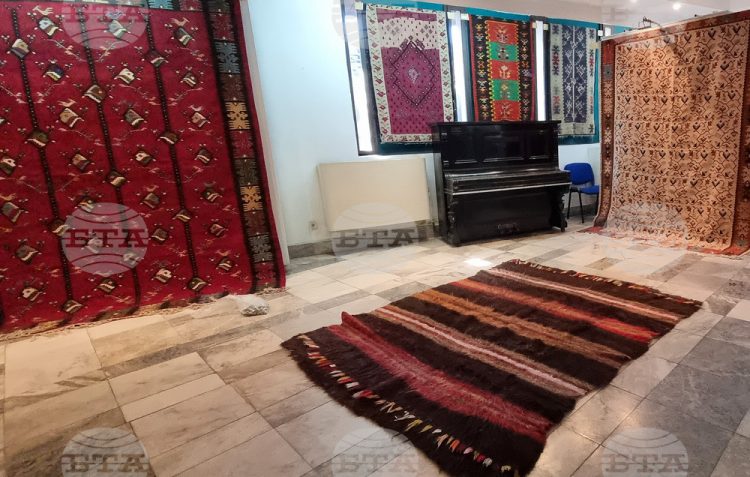Magic of Bulgarian Carpets Showcased in Grand Exhibition in Northern City of Lovech
Jerusalem, 20 September, 2022 (TPS-IL) -- Lovech, North Central Bulgaria, 20.09.2022 (BTA)
An exhibition of Bulgarian carpets from across the country opens on Tuesday in the Prof. Teofan Sokerov Art Gallery in Lovech, North Central Bulgaria. The exhibition is dedicated to the European Heritage Days, which in 2022 celebrated Sustainable Heritage.
The exhibition has six other venues – the courtyards of five period houses and the playground of a kindergarten in Lovech’s Varosha old town.
Visitors of the event will follow a specially designed route via the separate exhibition locations taking them through the 250-year history of Bulgarian carpet-weaving. Along the route, the visitors will learn little known facts about the craft of carpet-making, including natural dyeing methods, how the carpet designs came to be, and the different techniques and patterns used in the different carpet-weaving centers.
A special feature of the exhibition the fact that, along with carpets from well-known centers of Bulgarian carpet-weaving, such as Chiprovtsi (Northwest Bulgaria) and Kotel (Northeast Bulgaria), it also shows pieces from the area of Razgrad, Teteven, Karlovo, Kalofer, as well as Muslim prayer rugs from villages North of Aitos (Southeast Bulgaria) that have been scarcely researched by ethnographers and craft experts. Many of the carpets, or kilims, are shown for the first time.
The carpets, some of which are more than 200 years old, come from the personal collection of Dutchman Jaap Van Beelen who has chosen Bulgaria as his second homeland and who is an avid collector of Bulgarian fabrics, as well as a big fan of Bulgarian folk singing and dancing.
Jaap Van Beelen, who is a municipal councilor in the northern city of Veliko Turnovo, says that each of the kilims in his collection comes with its own captivating story.
Interviewed by BTA, Van Beelen said that he relocated in Bulgaria from the Netherlands eleven years ago. He first lived in Kotel in an old wooden house built in 1848 and right next to the Kotel Carpet Museum and a hundred meters away from the now extinct local cooperative where the distinctive Kotel carpets were woven. “What could be more beautiful than having Kotel carpets on the wooden floors in all of the eight rooms in the house,” Jaap says, adding that he bought the carpets from the locals. “Many people came forward to offer me heirloom carpets and very soon I ended up with three or four layers of carpets on top of one another in all the rooms and hallway spaces. This is how I started my carpet collection,” Jaap says.
He next purchased old carpets woven in Chiprovtsi. “The Chiprovtsi carpets are very different from the Kotel ones. The weaving technique is different, as are the designs. The Chiprovtsi kilims were made for the market while those in Kotel, for use in the household,” Jaap says. His collection includes over 750 carpets.
Four years ago Jaap decided to follow the kilim route: from Veliko Turnovo where he lives now, through Anatolia in Turkey and on to Georga, Armenia and Azerbaijan. “In Turkey the antiques markets were full with Chiprovtsi and Pirot carpets which can no longer be found in Bulgaria. In Bulgaria it is very difficult to find Bulgarian-made carpets from before the Liberation from Ottoman Rule in 1878. In the 1990s merchants from Turkey used to come to Bulgaria and tour locations from kindergartens to municipal halls, mosques and hotels, to offer trade-offs offering new Persian rugs in exchange of old Bulgarian kilims,” Jaap says. This is how a great number of heritage Bulgarian carpets found their way to the markets in Turkey from where they were taken to antique shops in Europe to become part of private collections. It is thanks to Jaap’s efforts to find and “buy back” such Bulgarian kilims, so that visitors can see many of the rare and valuable kilims in the current exhibition. “You should be proud of your culture and heritage,” he says.
In Lovech, Jaap is showing 130 carpets from his collection. This is the second big carpet exhibition he organizes, after a similar exposition in Veliko Turnovo in 2019.
Another highlight of the current exhibition is that it shows for the first time originals of manually drawn and dyed patterns for Chiprovtsi kilims made in the 1970s for the Bulgarian Academy of Sciences. Also on display are many books on the Bulgarian carpet-weaving traditions.
The exhibition continues until November 10.


